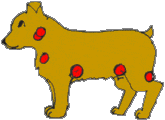At 5 years old we had to say goodbye to our beautiful Golden Retriever, Maddie. Just short of one month of displaying signs of canine lymphoma, she passed at home with some degree of struggle and surrounded by much sadness. At the time, I was 17 years old and didn’t possess the medical knowledge I do now. I also wasn’t aware that a gentle passing assisted by a veterinarian would have made the process slightly easier to bear.
Though the veterinary community and pet owners are more educated about the disease process, symptoms, and treatment options available, lymphoma in dogs is still prevalent. According to Purdue University College Of Veterinary Medicine, lymphoma accounts for 7-14% of all cancers found in dogs and resembles non-Hodgkin’s lymphoma in humans.
What Is Lymphoma?
Canine lymphoma is marked by enlarged lymph nodes or lymphatic tissue, often appearing as “golf balls” under a middle aged to senior dog’s neck. While multicentric lymphoma (which is confined to the lymph nodes) accounts for 84% of all lymphomas in canines, it can also have its primary source in the gastrointestinal tract or organs such as the eyes, skin, and chest.
Ultimately, many of the body’s systems are invaded as the cancer spreads to places like the spleen, liver, and bone marrow. Cancer is caused by a mutation and aggressive replication of B or T lymphocytes which normally act as part of the body’s immune system brigade, destroying abnormal cells or recognizing foreign invaders such as bacteria. (3)
While environmental triggers such as exposure to secondhand cigarette smoke, viruses, or the sun’s rays account for some types of cell mutations, a genetic component has been found which predisposes some breeds to lymphoma. According to the National Canine Cancer Foundation and Broad Institute breeds over-represented with this disease include: Boxers, Bull Mastiffs, Basset Hounds, Saint Bernards, Scottish Terriers, Airedales, Bulldogs, Cocker Spaniels, Golden Retrievers and Irish Wolfhounds. Using genetic information to manipulate the progression and development of disease is at the forefront of much cancer research.
What Should You be Looking For Canine Lymphoma?
The symptoms of canine lymphoma, otherwise known as lymphosarcoma are:
- Visibly enlarged lymph nodes in the neck, chest, or back legs
- Trouble swallowing, coughing, or sputtering when eating and drinking
- Difficulty breathing and increased panting
- Diarrhea with gastrointestinal lymphoma
- Losing appetite and energy
- Skin lesions that look like open sores or lumps
Many times, pets are still energetic and have a good appetite despite the enlarged lymph nodes or lesions.

The spots indicate the location of peripheral lymph nodes in dogs. Illustration by Dr. Wendy Brooks.
How Is Lymphoma Diagnosed?
A trained veterinarian will take a biopsy of the affected area and examine it closely under a microscope. A special staining of the sample may be performed to determine which type of malignancy your pet has developed. Other tests of the blood, urine, bone marrow, as well as imaging and sampling the internal organs with an ultrasound will help to determine how widespread the disease is. This is known as staging the cancer and gives veterinary oncologists an opportunity to better treat the disease and refine the prognosis.
How Can We Treat Lymphoma?
Dogs with multicentric lymphoma who do not undergo treatment typically survive only a few months. Treatment options and response to treatment depend on the type of lymphoma (B cell, T cell, small cell, low grade), stage of cancer, whether your pet is currently acting ill, whether they have received previous treatment for the disease, other concurrent illnesses, calcium levels at the time of diagnosis, and financial limitations. Most protocols involve giving a combination of chemotherapy drugs over several months. In general, dogs receiving treatment do not suffer the same effects as people such as nausea and hair loss.
The goal of treatment is to achieve remission, or at least regression. Remission is represented by a return of the lymph nodes to normal size and resolution of any signs related to the disease. 65-70% of dogs who receive some type of treatment protocol can expect to see a first remission. How long the remission period lasts varies on the type of treatment the dog receives.
The median survival time for B cell lymphomas is one year when receiving the most standard combination of chemotherapeutics. 25% of patients can expect a good quality of life for two years! More recently, a vaccine used to target and kill malignant cells has received conditional FDA approval adding to the toolkit to treat lymphoma.
As new treatment options become readily available and clinical trials at veterinary teaching hospitals are completed, we can hope to see a day when dogs with lymphoma stand a better chance at a cure.




